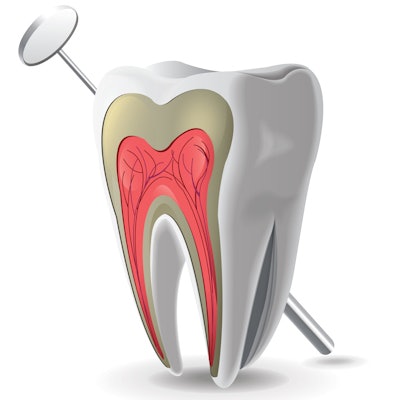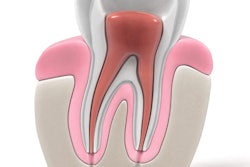
While amalgam, zinc oxide eugenol, or mineral trioxide aggregate are often used as filling materials for apical sealing in root canal therapy, is one better than another? Researchers from China undertook a literature review to weigh the evidence behind the materials.
While a number of clinical trials have been conducted to evaluate the safety and efficacy of different materials for retrograde filling in root canals, at no point has the quality of these studies been weighed. The authors of a review published in the Cochrane Database of Systemic Reviews (December 17, 2016) sought to clarify the clinical effect and safety of different materials for retrograde filling in root canal therapy.
"The purpose of our systematic review ... was to clarify the clinical effect and safety of different materials for retrograde filling in root canal therapy," they wrote.
The review team was led by Xiangyu Ma of the departments of endodontics at the Mianyang Hospital of Traditional Chinese Medicine in Mianyang and State Key Laboratory of Oral Diseases at the West China Hospital of Stomatology at Sichuan University in Chengdu.
The ideal filling material
Periapical surgery is the last chance to save a tooth that is failing in endodontics. So-called retrograde filling materials have proved to be critical for apical sealing, which the review authors labeled as the single most important factor in achieving success in periradicular surgery. They listed the following qualities for an ideal endodontic retrograde filling material:
- It adheres to the tooth structure.
- It is insoluble in tissue fluids.
- It is dimensionally stable.
- It is nonresorbable.
- It is radiopaque.
- It exhibits biocompatibility, if not bioactivity.
The authors wanted to weigh the quality of the evidence that supported the use of amalgam, zinc oxide eugenol, or mineral trioxide aggregate as filling materials.
They sorted through an initial list of more than 750 studies and ended up with six randomized controlled trials that compared different retrograde filling materials and whose reported success rate was assessed by clinical or radiological methods with at least 12 months of follow-up. The six studies included more than 900 participants and almost 1,000 teeth. However, all the studies had a high risk of bias, the authors reported.
The six studies examined five different comparisons:
- Mineral trioxide aggregate (MTA) versus intermediate restorative material (IRM)
- MTA versus super ethoxybenzoic acid cement (SuperEBA, Keystone Industries)
- SuperEBA versus IRM
- Dentine-bonded resin composite versus glass ionomer cement
- Glass ionomer cement versus amalgam
MTA studies
The authors found only weak evidence of little or no difference between MTA and IRM at the first year of follow-up in a study of more than 220 teeth (95% confidence interval [CI], 0.97-1.22). They found insufficient evidence of a difference between MTA and IRM on the success rate at the second year of follow-up in a study of 86 teeth (95% CI, 0.89-1.25).
They found insufficient evidence of any difference between MTA and SuperEBA at one-year follow-up in a study that included 192 teeth (95% CI, 0.96-1.10). The authors judged the quality of evidence as very low.
SuperEBA and glass ionomer cement studies
The other study involving SuperEBA compared it to IRM. The authors found weak evidence that IRM had a small increase in the success rate at the one-year follow-up compared with SuperEBA in a study with 194 teeth (95% CI, 0.80-1.01). They reported that the quality of the evidence was also very low.
“There is insufficient evidence to draw any conclusion as to the benefits of any one material over another.”
Glass ionomer cement was compared with dentine-bonded resin composite in the fourth included comparison. Here the authors found insufficient and weak evidence at one-year follow-up that dentine-bonded resin composite might be a better choice for increasing retrograde filling success rate compared with glass ionomer cement in a study with 122 teeth (95% CI, 1.60-3.59).
The fifth comparison included glass ionomer cement and amalgam. The authors reported insufficient evidence in a study of a difference between the materials at both the one-year (95% CI, 0.86-1.12; 105 teeth) and five-year follow-up (95% CI, 0.84-1.20; 82 teeth). They also noted the quality of evidence was very low.
Limited evidence
For the limitations of their review, the authors pointed out that all the included studies in their review had at a high risk of bias. They also noted the small sample size of the clinical trials, the limited diversity of the participants, and also that the results did not always agree.
The authors recommended that further randomized controlled trials be undertaken with a large number of participants from different races and that increasing the follow-up time is necessary.
For the practitioner, the authors could offer no conclusion as to which material should be used.
"Based on the present limited evidence, there is insufficient evidence to draw any conclusion as to the benefits of any one material over another," they concluded.



















